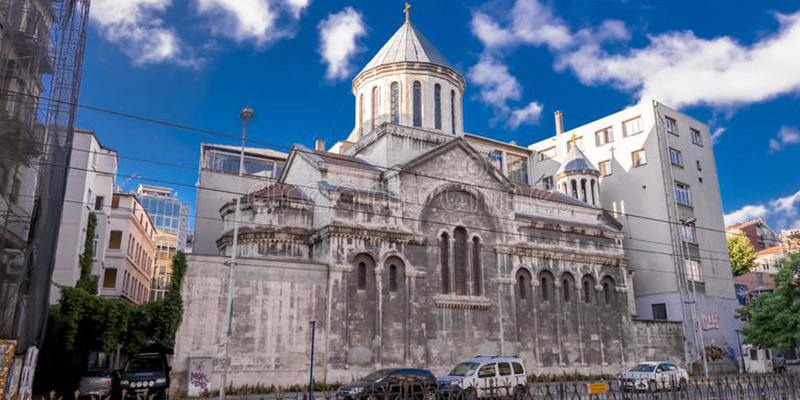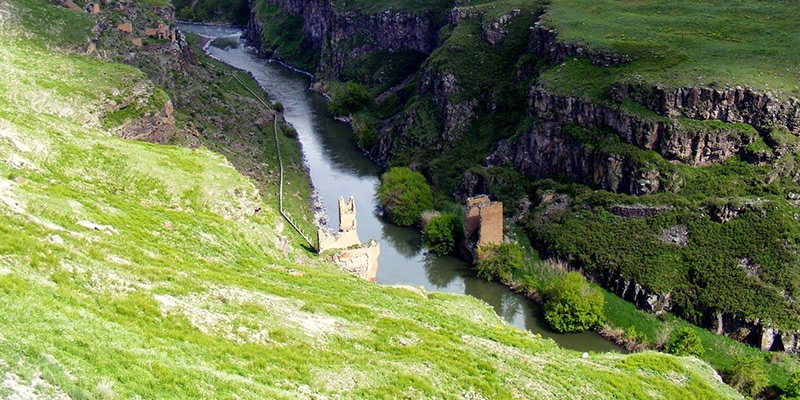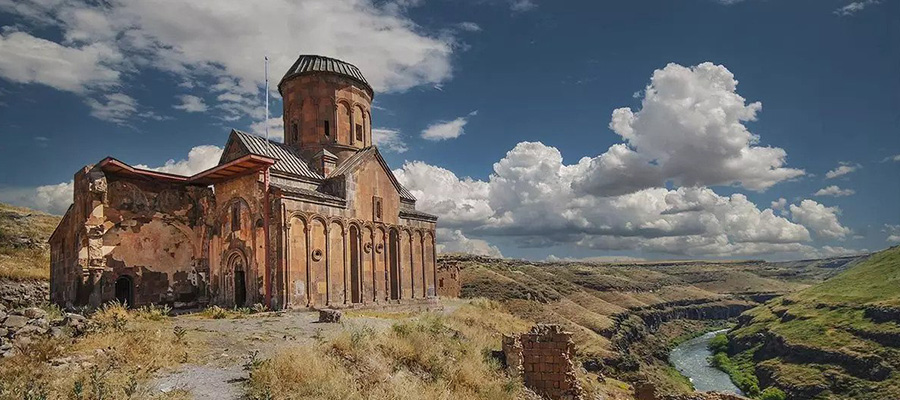The Ruins of Ani is located in Kars along the Arpacay River on the border of Armenia. It is included in the UNESCO World Heritage List. All seasons of the year have intense interest of local and foreign tourists. The Ani Ruins with a rich history are also called “Cradle of Civilizations”, “One Thousand Churches” “World City” and “40 Gate City”.
History Of Ani Ruins
The Ruins of Ani became the capital of the Pakraduni Dynasty between 961 and 1045. It is one of the special places that have hosted many civilizations throughout history and has various traces of different cultures. Another importance is that it is the first strategic transition gate from the Caucasus to Anatolia. In addition, it was found among the rich cities of the period as it is located on the Silk Road.
Surrounded by city walls, many ruins from Bagratuni Armenians, Byzantines, Georgians and Ottomans have survived to the present day. Some of these are 40 ruins of churches, chapels and monuments. The walls surrounding the Ruins of Ani were built by the Bagratuni Dynasty for defense.
The Ruins of Ani are heavily filled with Armenian, Georgian and Seljuk architectural structures. Although the region, which witnessed many bloody wars, was damaged in the Armenian – Byzantine, Byzantine – Seljuk Wars, it was heavily damaged in the earthquake of 1319. It was captured by the Seljuk Ruler Timur after the earthquake. In 1535, the city was completely abandoned during the Ottoman and Iran war.
In 1877-78, the region was conquered by the Russians in the Ottoman-Russian war. After the First World War, the Ottomans regained it. Later, the Armenians were conquered and the Republic of Armenia was established in the region. During the War of Independence in 1920 it has been included in the Republic of Turkey.
Ani Ruins is a 78 hectare plateau surrounded by 4500 meter walls. The region lived its brightest period in the 10th and 11th centuries during the 3rd Ashot, 1st Simbat and 1st Gagik periods. The capital of the Armenian Kingdom of Bagrat has also been an important stop in the historical Silk Road. In this period, cathedrals, palaces, churches, bazaars and bridges were built. The most important structures are Cathedral of Ani, Saint Prkitch Church, King Gagik Church and the Nuns Monastery. These are the structures built with the unique architecture of the period.
Cathedral of Ani

When you enter the the Ruins of Ani from the Lion Gate, the first striking structure is c. It impresses those who see it with its magnificence and elegance. The Cathedral, which was started in the 1st Gagik Period, was completed in 1001 by Gagik’s wife Katranide.
Cathedral of Ani was designed in the form of a cross. Trdat is the architect of the building, which resembles gothic architecture with its giant columns, frescoes and swellings. It was an example of Armenian churches to be built later. The city’s notables built many churches and chapels, taking the example of Cathedral of Ani to imprint their names in history.
Cathedral of Ani was built of red tuff stone. The middle nave is covered with a dome, and cells are added to both sides of the semicircular apse. There are 3 entrance doors. There is the People’s Gate in the west, the Patriarch Gate in the north and the King Gate in the south. Its windows are enclosed in round arches and its façade is animated with triangular niches and decorative columns. There are hollows with sculptures in the apse. In the building used as a mosque in the Seljuk and Ottoman Periods, pulpit and mihrab were added to the building and it was named as Fethiye Mosque. Today, it is tried to survive with steel supports.
Abukhamrents Saint Krikor Church
One of the Ruins of Ani, the Church was built in 994 by Prince Krikor from the Armenian Bahlavuni Dynasty. Prince Krikor had it built as a resting place for his brothers Hamza and Seda. The plan of the church was designed with an aperture from the inside and a clover from the outside. There are triangular niches and windows on its massive walls. It has a conical roof with a high pulley. Twelve windows on the roof illuminate inside.
The building is one of the best examples of stone chipping art. Since it is a family structure, graves belonging to the family are located around the church. Restoration was carried out in 2012 and around it, kitchen stoves, ceramic ware pieces, human bones were found around it. There is an inscription on the church wall that tells the feelings of Prince Krikor.
Surp Kirkor Church – Ani Ruins

It was built by Prince Dikran Honentz in 1215. It is also known as Dikran Honentz Church. It is located in the northeast of the Ruins of Ani. It attracts attention with its rich frescoes about Krikor Lusavorich’s life, which allowed Armenians to pass into Christianity.
Genc Kızlar Church (Maiden’s Monastery)
The church was built in the 13th century. It is on the crossing road of caravans. It has spectacular features with its cylindrical plan, wall reliefs and decorations, and the dome’s tent appearance.
Nuns Monastery (Maiden’s Castle)
It is one of the 13th century buildings. Although it is difficult to reach, it is one of the places worth seeing. It is surrounded by high walls on steep cliffs. The church of the monastery dedicated to the nuns of St. Hripsime has survived to the present day without much change in its structure. The church is of small scale and built of red cut stones. The plan was designed in the form of a six-leaf clover. There is a chapel adjacent to the church. The dome of the building has a conical shape.
Abughamrents (Poladoglu) Church
Built in 980, the church is located to the northwest of Ani Ruins. It is close to the walls and it was built by Prince Pahlavuni. The dome of the building in cylindrical form is octagonal. The dome stands on six columns. The interior architecture and acoustics of the church, which has a very nice architecture, is quite good. It is one of the Ruins of Ani that has survived to the present day and is the most photographed.
Abu’l Manucehr Mosque
It was built in 1072 by the Seljuk Shaddadid Emir of Manuchihr. It is the first Turkish Mosque in Anatolian territory. The mosque, which has an octagonal minaret, was completely destroyed in 1917, only a ruined part of it has survived to the present day.
Silk Road Bridge

Although the construction date is not known exactly, M.S. It is thought to have been built in the 9th century. It is located at the location where 6400 km long Silk Road enters Anatolia. The ground floor of the two-story bridge is for caravan crossings and the upper floor is for pedestrian and military crossings. Bridge feet on both sides of the Arpacay River have survived to the present day and restoration works are underway.
Seljuk Caravanserai
Located in the center of Ani Ruins, the caravanserai was built in the 12th century. It was combined with the Arekletos Church built in the 10th century. The first floor of the two-storey building was demolished because it was made of wood and only the ground floor and basement floor could survive. The crown gate decorations reflect the original Seljuk architecture features. The main entrance door made of yellow stone has a very majestic appearance. The fountain inside the building is one of the important architectural structures.
Seljuk Palace
The Palace, which was built by the Seljuks, was built with 3 floors and only 2 floors could survive to the present day. The stone workmanship of the Seljuk architecture attracts attention. The plan has a rectangular design, and there are rooms around it.
Large and Small Baths
Only bathing places of the baths, which are among the Seljuk artifacts in Ani Ruins, have survived to the present day. Although other places have been demolished, it is one of the places worth seeing.
Temple of Fire
It is one of the oldest Ani Ruins. It is thought to have been built in the 4th century. It is a place of worship belonging to the first period of Christianity. The upper part of the building has been demolished. Its plan is in the form of a baldachin, formed by four large columns, placed on high cylindrical bases. In the 12th century, the columns were knitted and turned into a four-leaf clover planned chapel.
Horomos Church
The 10th-century church is located 5 km outside of Ani Ruins. It is the only church that has survived from the Middle Ages.
You can go to Ani Ruins every season, but we recommend you to go with the Eastern Express in the winter months. The region covered with snow dominates a magnificent view.
You can click Byzantine Buildings in Istanbul.

